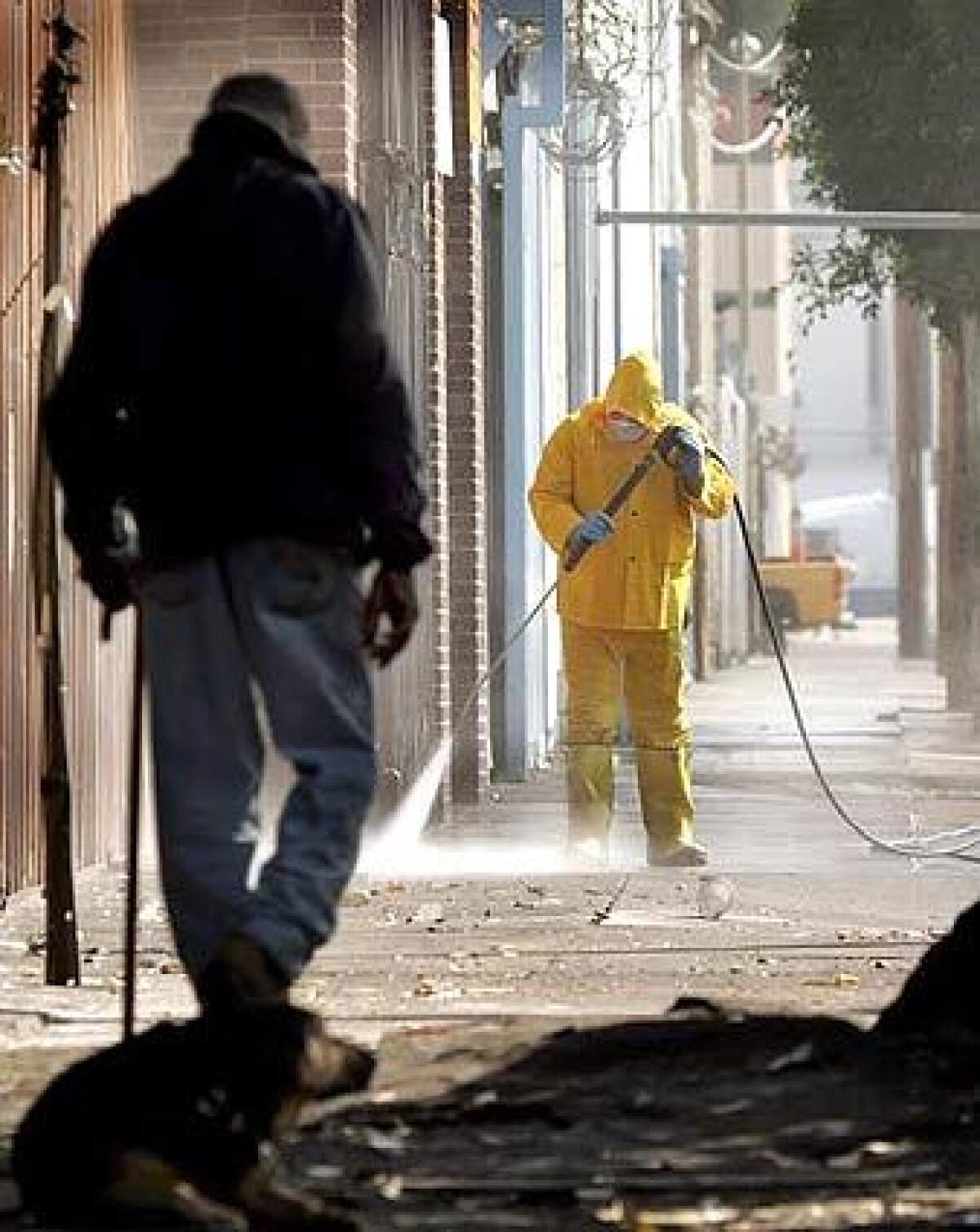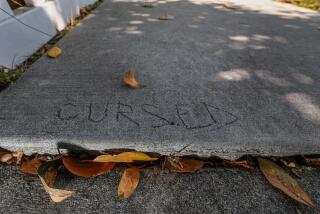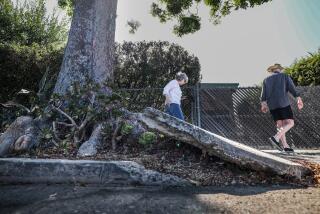Sharp Debate on Skid Row Efforts

The push to clean up Los Angeles’ skid row reached an unlikely milestone Tuesday morning when downtown business leaders moved in to steam-clean the sidewalks on one of the district’s filthiest streets.
The business leaders said they took action out of frustration with how grimy and potentially unhealthy the sidewalk, which fills at night with homeless encampments, was becoming.
But the move sparked criticism from some homeless advocates, who worry that the effort is a subtle way of pushing the homeless out in favor of additional high-end lofts that are coming to surround skid row. A few protesters carried picket signs as workers scrubbed.
The fact that the simple act of cleaning a sidewalk became a political battle underscores just how sensitive the issue of gentrification on skid row has become.
Mayor Antonio Villaraigosa and other top city and county leaders have vowed to improve skid row, which has the largest concentration of homeless people in the Western U.S. and is also home to a large drug market.
At the same time, the revitalization of the entire downtown and the influx of well-heeled residents to the historic buildings around skid row have brought new pressures on officials to clean up the area.
The sidewalk sweepers came first Tuesday, decked out in red T-shirts that identified them as employees of the Central City East Assn., the business improvement district for the area of downtown Los Angeles that includes skid row. They pushed large brooms, sweeping up debris, paper and metal in their wake.
Then came the hose man, clad from head to toe in bright yellow, who used high-pressure streams of water to clean the dirty sidewalks, which in some places were littered with feces and urine. Another worker used a vacuum to reclaim that water, and the sludge that went with it, rather than let it escape into storm drains.
A bright yellow city street-cleaning truck drove down the street, sweeping, as if in tandem with the sidewalk crew.
But before the cleaning team could get a full block down Gladys Street, between 5th and 6th streets, a group of protesters hindered the operation.
The protesters — homeless advocates — blockaded the city trucks, saying they objected to what they consider an increasing campaign to harass homeless people and ultimately drive them from the area.
It wasn’t so much this particular cleaning effort, they said.
The problem was what they termed the ongoing harassment of homeless people by city street cleaners and the police officers who accompany them through the area.
“L.A. city homeless policy is those trucks,” said Jeff Dietrich, a member of the Los Angeles Catholic Worker, whose hospitality kitchen is at the corner of 6th and Gladys. “They just don’t clean the sidewalks. They take possessions.”
The street sweeping was organized by the Central City East Assn. Estela Lopez, the group’s executive director, said property owners have a legal obligation to maintain their sidewalks and keep them clean.
Before, she said, the group had been routinely sending red-shirted workers to sweep the sidewalks.
“But the size and scope of the encampments has increased dramatically in the last couple of months,” Lopez said. “And so has the public health concern.”
Lopez stressed that the goal wasn’t to rouse the homeless who camp out on the streets but to clean up the area.
“Everyone on the street, once they understood we were there simply to make the place cleaner for everyone, they picked up their stuff, moved it, and most of them are back “ she said. “We didn’t tell them where to go, just asked them to lift up their stuff, and once it dried they moved right back. That’s all we asked them to do.”
But several groups working downtown have objected to what they see as the criminalization of homeless people by authorities, and cited the fact that the cleaning crews were accompanied by LAPD officers.
“If you see street cleaning in any other neighborhood, you don’t see the police presence,” said Becky Dennison of the Los Angeles Community Action Network, a downtown-based advocacy group for the homeless,
Dennison said her group has filed 20 property claims on behalf of homeless people whose belongings were taken in street-cleaning efforts over the last month and a half.
LAPD Capt. Andrew Smith, who oversees the Central Division, said officers often accompany the maintenance crews for their protection. He said that sometimes people in “drug-induced states or with psychological issues attack the street maintenance guys.”
Nelson Ware has been living in and around skid row for at least 20 years. Tuesday he was camped out on Gladys, his area on the street crowded with personal belongings and bicycle parts. Ware said he builds and fixes bicycles for money.
Ware said that he has grown tired of losing his possessions to street cleanings. He cited a recent incident in which he was asked to put his belongings into the street: “Then they took it as trash. Everything but my tent and a couple of blankets.”
Asked about the sidewalk-cleaning efforts Tuesday, Ware said that it had been done correctly, with fliers distributed in advance and a crew that did not take anyone’s belongings.
But he said that typically the city’s street cleaners come without association workers — or members of the media — on Fridays. “Then,” he said, “we have to worry.” The sidewalk-cleaning standoff came in the midst of an ongoing debate about how best to grapple with the issues that have long plagued skid row, a 50-square block area that is home to the region’s largest concentration of shelters and homeless people.
The county recently set aside $100 million to reduce the concentration of homeless services in skid row by establishing five centers across the county that would provide temporary shelter and social services for transients.
In April, the U.S. 9th Circuit Court of Appeals ruled that unless adequate shelter is available for L.A.’s homeless people, the Los Angeles Police Department can not arrest people for sleeping on city sidewalks because such arrests amount to cruel and unusual punishment.
City officials have said that they will appeal the decision. But in the meantime, Deputy Chief Lee Carter told the Police Commission on Tuesday that the LAPD will assign additional city prosecutors and parole and probation officers to the area, as well as add cameras and more lighting, mostly to help reduce crime in the zone.
Along Gladys Street on Tuesday, the protest started quietly but got more animated.
Alice Callaghan of Las Familias del Pueblo, an advocacy group for the homeless, said the LAPD was to blame for the “huge campground” on Gladys, because authorities effectively forced homeless people into a certain area.
After about 45 minutes, Dietrich, clutching a sign that read, “House the Homeless, Don’t Harass Them,” decided to lie down under a cleaning truck. “I’ve got all day,” he said, though his protest lasted less than hour. “I’m here making a statement.”More to Read
Sign up for Essential California
The most important California stories and recommendations in your inbox every morning.
You may occasionally receive promotional content from the Los Angeles Times.










